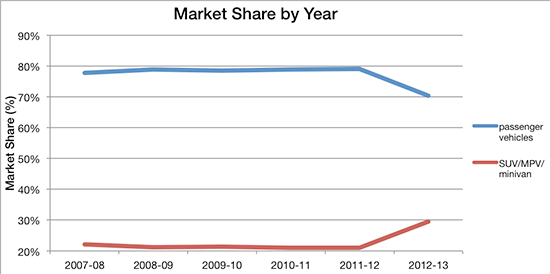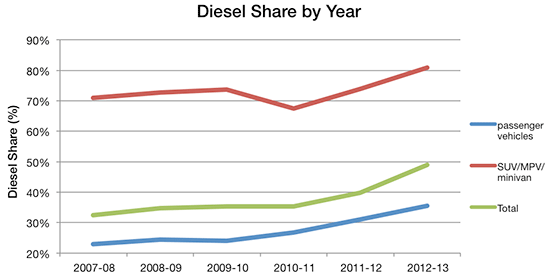Blog
Diesel Cars in India: Still Problematic
Last year, my colleague Gaurav Bansal predicted that diesel vehicles’ share of the passenger car market in India could rise to 60% by 2030. It seems that he underestimated diesel’s allure. Statistics from this past fiscal year (April 2012 to March 2013) show a 10% increase in diesel market share of new car sales in India over the previous year, putting diesels at 50% of the market already. At this rate, diesel passenger vehicles will hit that 60% mark in 2020—a full decade sooner than that estimate of only a year ago.
We at the ICCT have been drawing attention to two points in particular about diesel vehicles in India. First, under India’s current vehicle emission regulations, they do much more damage to public health than gasoline cars. Although they are more efficient and get better mileage, diesel cars in India are allowed to emit many times more PM and NOx. Second, government subsidies of diesel fuel costs have distorted consumer preference in favor of diesel cars despite their more harmful effects on air quality and public health.
But diesel fuel subsidies are being phased out. Why then are diesel cars still gaining market share?
A couple of reasons. First, the difference in retail price between diesel and gasoline will remain Rs. 10 (U.S. $0.20) even after full elimination of diesel subsidy. This means that diesel car owners will still save money in the long run over gasoline car owners. Consumers who don’t realize the environmental and health disadvantages of diesels over gasoline (or who don’t care) will naturally take advantage of the fuel price difference.
Second is the increasing number of MPV/SUV vehicles on the road compared to smaller cars. Indian car buyers are choosing utility vehicles because they are bigger and more comfortable, and almost all Indian utility vehicles run on diesel. The chart below shows the gains in market share over the last year of SUV/MPV/minivans at the expense of passenger cars.

The next chart shows the larger pattern: the SUV/MPV/minivan segment is dominant in diesel engines and the diesel share is increasing in that segment, in the passenger vehicles segment, and overall.

Diesel car sales will not decline anytime soon. This year Honda launched its first diesel car in the Indian market, a version of the Amaze. Honda sold 4,852 Amazes of both types in the first month (April 2013), more than any other model in its lineup—and more than 85% were the diesel version. In fact, Honda is now competing with popular diesel models from other manufacturers.
What does this accelerated dieselization of its passenger car fleet mean for India? For one thing, pollution levels and premature deaths will rise even higher than previously predicted. If diesel share does in fact reach 60% by 2020, an extra 52,000 metric tons of particulate matter will be emitted into the India air through 2030—that is, over and above the current estimates for rising PM emissions from diesels—which would translate into some 6,000 additional premature deaths.
What could be done to change this trend? An added excise tax on diesel vehicles would reduce the purchase incentive. At least until the price gap between diesel and gasoline fuel falls to zero—or, more likely, is reversed—some sort of excise tax is the most likely way to influence that harmful consumer preference.
Of course, none of this would really matter if India were to move to Euro 6 equivalent standards, which is a point we’ve made many times over. Under Euro 6, diesel cars would emit roughly the same amount of PM and NOx as gasoline vehicles. If this could happen soon, consumers would get the better fuel efficiency they desire along with a clean vehicle. An added excise tax on diesel cars would be unnecessary. It would be a win-win-win situation for India.
